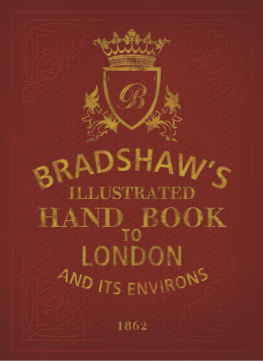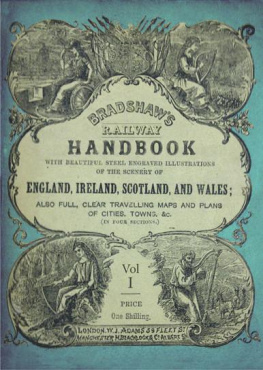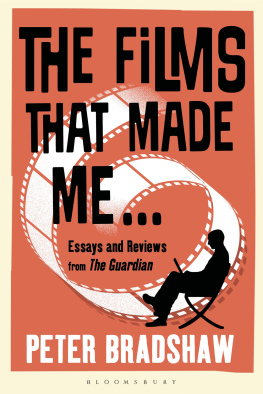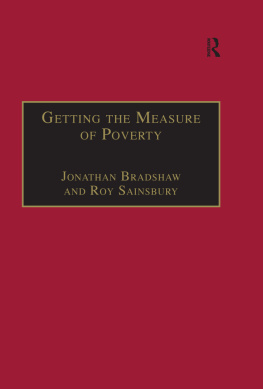George Bradshaw - Bradshaws Handbook to London
Here you can read online George Bradshaw - Bradshaws Handbook to London full text of the book (entire story) in english for free. Download pdf and epub, get meaning, cover and reviews about this ebook. year: 2019, publisher: Bloomsbury Publishing, genre: Detective and thriller. Description of the work, (preface) as well as reviews are available. Best literature library LitArk.com created for fans of good reading and offers a wide selection of genres:
Romance novel
Science fiction
Adventure
Detective
Science
History
Home and family
Prose
Art
Politics
Computer
Non-fiction
Religion
Business
Children
Humor
Choose a favorite category and find really read worthwhile books. Enjoy immersion in the world of imagination, feel the emotions of the characters or learn something new for yourself, make an fascinating discovery.
- Book:Bradshaws Handbook to London
- Author:
- Publisher:Bloomsbury Publishing
- Genre:
- Year:2019
- Rating:3 / 5
- Favourites:Add to favourites
- Your mark:
- 60
- 1
- 2
- 3
- 4
- 5
Bradshaws Handbook to London: summary, description and annotation
We offer to read an annotation, description, summary or preface (depends on what the author of the book "Bradshaws Handbook to London" wrote himself). If you haven't found the necessary information about the book — write in the comments, we will try to find it.
George Bradshaw: author's other books
Who wrote Bradshaws Handbook to London? Find out the surname, the name of the author of the book and a list of all author's works by series.
Bradshaws Handbook to London — read online for free the complete book (whole text) full work
Below is the text of the book, divided by pages. System saving the place of the last page read, allows you to conveniently read the book "Bradshaws Handbook to London" online for free, without having to search again every time where you left off. Put a bookmark, and you can go to the page where you finished reading at any time.
Font size:
Interval:
Bookmark:


This electronic edition first published in Great Britain in 2018 by Shire Publications,
part of Bloomsbury Publishing Plc
PO Box 883, Oxford, OX1 9PL, UK
1385 Broadway, 5th Floor, New York, NY 10018, USA
Email: shire@shirebooks.co.uk
Website: www.shirebooks.co.uk
First published 1861
First Conway edition 2012
First Bloomsbury edition 2015
All rights reserved. No part of this publication may be reproduced, stored in a retrieval system, or transmitted in any form or by any means electronic, mechanical, photocopying, recording or otherwise, without the prior written permission of the publisher.
No responsibility for loss caused to any individual or organization acting on or refraining from action as a result of the material in this publication can be accepted by the publisher or the author.
A CIP record for this book is available from the British Library.
Print ISBN: 978-1-7844-2332-2
ePub ISBN: 978-1-7844-2333-9
Publishers Note:
In this new edition, typographical errors in the original have been corrected, with the exception of instances where the common spelling of Victorian words would seem to differ to their modern-day equivalents. Examples include: visiters; Magna Charta; and Shakespere. Although these do occasionally take the modern form. The two maps titled Map of London and Map of the Environs of London (25 miles round), which originally appeared opposite the Title and at the end of the book cannot be reproduced in this edition due to the limitations of size.
_______
George Bradshaw (18011853) was an English cartographer, printer and publisher. He is most famous for developing a series of railway timetables and guides, recently popularised by Michael Portillo in his TV series Great Railway Journeys. These became synonymous with their publisher so that, for Victorians and Edwardians, a railway timetable was a Bradshaw. After his death Punch magazine said of Bradshaws labours: seldom has the gigantic intellect of man been employed upon a work of greater utility.

_______
T HE object of this work is to supply a compact yet compendious Guide to the Sights of London, and the chief places of interest and attraction within a circuit of thirty miles, so as to give the greatest amount of information in the smallest compass.
The present edition has been remodelled in the form of an Itinerary, and is divided into such portions or routes through each district of London as the reader will be able to visit in a given time. Every object worthy of attention in the great metropolis is distinctly noticed, and each days routes are so carefully and clearly arranged that the confusion and unnecessary fatigue incidental to an irregular and discursive wandering hither and thither will be obviated, while each days walks are varied to diversify the scenes, render them entertaining, and thus enhance the pleasure of a visit to London.
Visitors, however, must be aware that their enjoyments of the most alluring scenes depend, in a great measure, on the frame of mind in which they admire, criticise, or satirise the various objects and peculiarities that come under their notice. A person in good humour always sees the sunny side of every cloud, while another is too prone to be prejudiced by unfavourable impressions. An anecdote is related of the impressions received by two old ladies, who went to receive their dividends at the Bank, which humorously illustrates how different minds are affected by the same circumstances, as noticed by dispositions of a diametrically opposite character.
A gentleman having called upon those ladies, on their return from the city, he was addressed as follows :
Well, Mr. H., said Mrs. P. to him on entering the room, we had a most agreeable ride to the Bank on Thursday, everything looked so lively; and, though we were tossed about over the rough stones, it was amusing to see the variety of people and the numerous carriages; such faces full of business, such evidences of a brilliant commerceI was quite sorry when we got home again. Mrs. L., the sister, then entered the room, and, not having heard a syllable of the above, approached Mr. H. with an air as if expecting condolence. I suppose, she remarked, my sister has told you that we were almost jolted to death in that rumbling coach the other day; and it was so hot with the sun shining on it, and we were such a long time, drawl, drawl, through Fleet Street and Ludgate Hill, that I thought we should never have reached the end of our journey! I wish we could be saved the trouble of going for our money another time.
The grumbler was by much the most robust of the two; it was simply, then, the contrast between a mind disposed to receive pleasure wherever it was possible to extract it, and one attentive only to inconveniences, that caused these opposite remarks.
After three or four days visit to the sights of the metropolis, the reader may wish to take an excursion for a day or two to some of the places of attraction in the vicinity of London, to recruit his energies and spirits, and complete his walks in the metropolis.
Among the most attractive of these excursions are those to the Crystal Palace, at Sydenham, one of the greatest treats imaginable, surpassing all conception; those to Windsor Castle, Hampton Court, Richmond, &c., &c., particulars of which will be found in the Appendix, with the necessary information as to conveyance to and from each of these places.
_______________________________
LONDON (1590) IN THE REIGN OF QUEEN ELIZABETH.

THE STRAND, FLEET STREET, AND ST. PAULS (LOOKING EASTWARD),
With Old London Bridge and the Church of St. Mary Overy, Southwark, in the distance.
_____________
I T would be at once tedious and unsatisfactory, within the limited space to which we are necessarily restricted, if we attempted to follow through the successive reigns the different changes by which the metropolis was affected. The massacre of the Jews in the reign of Richard I.; the election of Henry Fitz-Alwyn as Mayor in the reign of King John; the rebellion of Wat Tyler in the fifth year of the reign of Richard II.; the continuous wars, alternating with the ravages of famine and pestilence, and the institution of various offices which arose out of the granting of additional privileges, are all amply recorded in the larger histories of the metropolis, but can here be little more than referred to. It will be a far pleasanter task to the reader than wading through the dry details of antiquitywhich would be little more than a mere string of dates as we should be compelled to present themif we glance instead at the City under its more graphic aspects, and by that means contrive to invest the information we are able to afford with a few points of acknowledged general interest.
We have some curious evidence in the old maps about the time of Elizabeth to show what London really was prior to the change effected by the great fire of 1666. It would be a singular contrast to conjure up before the mental vision of the omnibus passenger of the present day the appearance of the unpaved, unbuilton highroad of the Strand, even as it existed so late as the reign of the second Charles. The line, now unbroken, between London and West-minster, was then only conspicuous for a few scattered houses, and a village which afterwards gave a name to the whole. The church of St. Martins literally stood in the Fields, and all the houses on the south side had large gardens down to the rivers edge, which were all distinguished by the names of the owners, and have since given rise to the various names of streets built on their site. At the end of these gardens were stairs for the convenience of taking boats, a customary conveyance then from the City to the Court. The north side of the Strand was a straight line of houses from Charing Cross to Temple Bar, and all beyond was country. The convent gardens, which then occupied part of the site of Covent Garden, were then bounded by open fields, and St. Giless was a little distant country village. The carriage ways were left unpaved, and in wet weather the soft mire therein was left to accumulate until it became several feet deep. Westminster had only a few detached houses on each side of Tothill Street, some having large gardens stretching towards the Park, and some on the other side with gardens extending to Orchard Street. The Gate House (demolished in 1777) at the entrance of Tothill Street, was used as a prison for state, ecclesiastical, and parliamentary offenders, as well as for debtors and felons. The latter were brought hither through Thieving Lane and Union Street, to prevent the possibility of the culprit escaping from justice by entering the hallowed liberties of the sanctuary. Here was imprisoned the illustrious Raleigh immediately previous to his execution in Palace Yard. Even so late as 1763, Buckingham House enjoyed an uninterrupted prospect south and west to the river, there being only a few scattered cottages and the Stag Brewery between it and the Thames. There were none of those filthy courts between Petty France and the Park, nor any buildings in Palmers Village or Tothill Fields, or by the Artillery Ground. There were a few pretty villas about Pye Street and Duck Lane, and these were surrounded with gardens on the banks of a pleasant stream of water; but beyond these there were no other buildings whatever.
Font size:
Interval:
Bookmark:
Similar books «Bradshaws Handbook to London»
Look at similar books to Bradshaws Handbook to London. We have selected literature similar in name and meaning in the hope of providing readers with more options to find new, interesting, not yet read works.
Discussion, reviews of the book Bradshaws Handbook to London and just readers' own opinions. Leave your comments, write what you think about the work, its meaning or the main characters. Specify what exactly you liked and what you didn't like, and why you think so.











